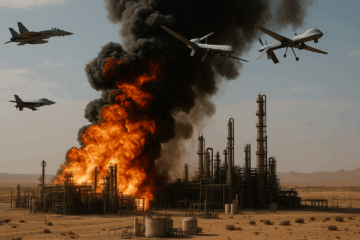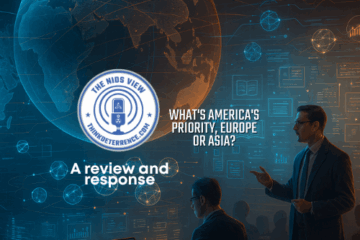Since the Islamist Revolution (1979) Iran’s strategic intent experienced little change—drive the United States out of the Middle East. The Iranian regime aims at establishing dominance in Iraq, Syria, Lebanon, the West Bank and Gaza, Yemen, and the Gulf of Aden.
There are two ways to achieve the regime’s objectives. First, Iran can cross the nuclear threshold and turn the tables on the United States, Israel, and the Sunni Arab states. Second, Iran can continue engaging in conflict and terrorism via proxies.
This approach took shape with the 1983 Marine barracks bombing, which drove the US out of Lebanon. The United States and Israel’s current conflict with Iranian proxies is at best a strategic distraction that cost the lives of American troops and drains Israel of resources. Houthis militias not only disrupt 15–25 percent of global shipping, but they are also a vector for testing increasingly lethal weapons and tactics.
When recently fighting Islamist militias in Idlib, Syria, Iranian forces demonstrated the brand new Kheibar Shekan ballistic missile with a range of 1,450 kilometers (900 miles). This puts Israel within range, making the Iranian threat to “raze Tel Aviv and Haifa to the ground” even more explicit.
While the West is distracted by the persistence of proxy attacks, Iran’s laser-sharp focus on nuclear and ballistic missile capabilities continues to deliver results. As of early 2024, Iran is capable of Uranium enrichment above the 80 percent threshold, while it keeps growing its stockpile of Uranium enriched to 60 percent. Iran might not have yet mastered Uranium-metal machining and the implosion trigger, but it eventually will, albeit with a little bit of help from the enemies of the United States. It is not a question of if but when will Iran field a nuclear weapon.
Iran has long developed the largest and most diverse arsenal of ballistic missiles in the Middle East. It took nearly three decades for Europe to acknowledge that Iran’s ballistic missile capabilities were a growing threat. Western inability to deploy coercive nonproliferation tools that effectively compel Iran to cease and desist with its nuclear and ballistic missile programs demonstrates that efforts to deter Iran are an epic failure. It is in that context that Iran’s space launch vehicle programs provide a pathway toward longer-range ballistic missile systems, something not fundamentally different from North Korea’s approach.
The current American bombing campaign in retaliation for the attack on American troops in Jordan, while targeting proxies, does not change Iran’s tactical or strategic objectives. It is not a stretch to anticipate that Iran may consider a theater nuclear paradigm. For this to be adopted, Russian tutelage of Iran as to the utility of its nuclear doctrine is needed.
There remain several issues to consider. These include warhead miniaturization, mating with a Shahab 3 missile, and missile guidance, which require assistance from Russia, China, or North Korea. North Korea spent the past decade working on these very issues and is likely to share its knowledge for a price.
China relies heavily on Iran and Iran-controlled Iraq for its oil imports. Iran’s export of crude oil recently reached a 5-year high with China as the top buyer. Sanctions simply do not work. In addition to the expanded Brazil, Russia, India, China, South Africa (BRICS) and the Global South’s emerging alternative payment systems, which bypasses dollar-based control infrastructures, illegal weapons/technology proliferation continues unabated. While it is concerning that components used in Iranian missiles are reported to have made their way from the United States to Iran via China, the obvious question is what export-control designated items should never have made it out of the United States in the first place.
By staging a rapprochement between Iran and Saudi Arabia and accelerating the expansion of the BRICS to countries that are primarily oil and gas suppliers, China is further consolidating its energy security and its appeal as an alternative to the Western-led world order. Saudi Arabia, under the leadership of His Royal Highness Mohammed bin Salman Al Saud, maintains bridges with Iran while performing diplomatic damage control such as in Lebanon. This does not mean that Saudi Arabia will ultimately turn its back on the West. But by keeping its options open, Saudi Arabia’s smart diplomacy does not lose sight of its own strategic goals—leveraging any weight China already carries around the Middle East and globally.
In January 2024, a Qaem 100 rocket from the Aerospace Force of Iran’s Islamic Revolution Guards Corps, for the first time, launched a Soraya satellite to an altitude of 750 kilometers. Not long after this first success, a Simorgh (Phoenix) rocket launched 3 small satellites into orbit. Iran’s missile program, under the guise of a space program, demonstrated significant breakthroughs just as Iran is on the brink of reaching its technical goals for its ballistic missile and nuclear weapons programs. As the West contemplates failed deterrence policies, the United States and other western nations must contemplate how much longer they can continue to fail without having to pay a price for their eroding regional and global leadership.
Iranian effort to reassert itself to regional hegemony after a long period of mediocrity will not go unchallenged by the Saudis (Sunni Arab) or Turks (Sunni Turkish). American preeminence in the region kept old animosity at bay but may not for much longer. We will all be worse off for it.
Christophe Bosquillon has over 30 years of international experience in general management, foreign direct investment, and private equity and fund management across various industries in Europe and the Pacific Basin. Views expressed in this article are the author’s own.
About the Author

Christophe Bosquillon
Christophe Bosquillon is a Senior Fellow at the National Institute for Deterrence Studies. He has over 30 years of international experience in general management, foreign direct investment, and private equity and fund management across various industries in Europe and the Pacific Basin.





An excellent piece by Chris Bosquillon. Thought provoking and concerning. For how much longer will Iran’s extremist regime and its terrorist proxies hold the military initiative around the Middle East? They are increasingly running circles around the U.S.’s reactive stance and denialist posture there! E.g., after years and years of wrangling, Iran is on the very doorstep of becoming a regional nuclear power. The Houthis are parlaying their strategic position along the Red Sea into a stranglehold on global shipping. They are forcing the U.S. Navy into (defensive) fighting on yet another global front (beyond WESTPAC, NORTHCOM, and the Eastern Med — Israel and Ukraine) that we lack capacity (and political will?) to sustain. We will pay a high price indeed, worldwide, just as author C.B. warns, if Turkey and or Saudi Arabia go to war with Iran or get their own nuclear weapons in response to Iran proliferating — or both. 🙁